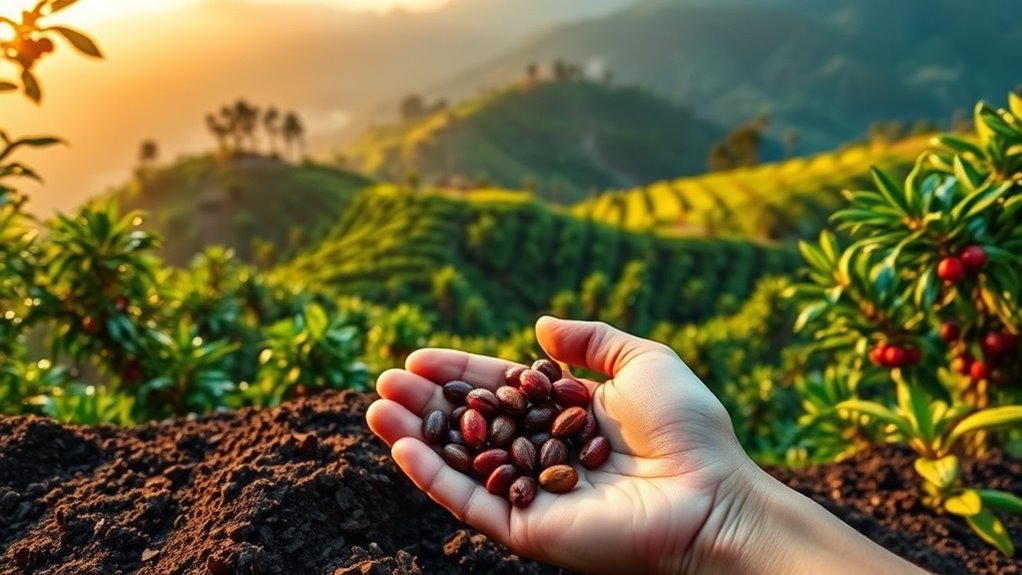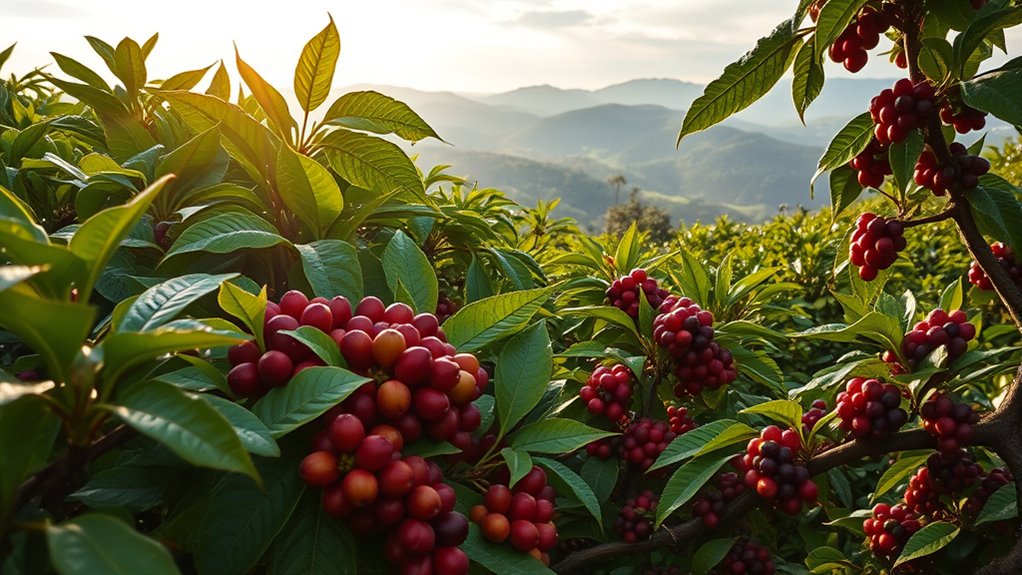The spread of coffee plants to Asia and the Americas began through trade, exploration, and innovation by farmers and traders. Early farmers in Ethiopia experimented with different cultivation techniques and adapted plants to local climates. Knowledge transfer and selective cultivation helped coffee flourish in new regions, with genetic diversity playing a key role in resilience. If you explore further, you’ll discover how small experiments and regional choices transformed coffee into a global commodity.
Key Takeaways
- Coffee spread from Ethiopia through trade routes, carried by explorers and traders to Asia and the Americas.
- Knowledge transfer and local experimentation enabled adaptation of coffee cultivation to diverse climates.
- European colonial powers established plantations, facilitating large-scale coffee planting in new regions.
- Farmers’ regional selection and cultivation techniques enhanced growth, resilience, and productivity of coffee plants.
- Preserving genetic diversity and ongoing research supported sustainable expansion into Asia and the Americas.

Change often begins with a single idea, and “Seeds of Change” explores how small actions can lead to profound transformations. When it comes to the spread of coffee plants to Asia and the Americas, that idea was rooted in curiosity, trade, and innovation. You might not realize it, but the way coffee was cultivated played a pivotal role in its global journey. Cultivation techniques evolved as farmers adapted to different climates and terrains, allowing coffee to thrive far from its original origins in Ethiopia. These methods included selective pruning, shade management, and soil enrichment, all of which helped optimize growth and yield. As coffee plants traveled, farmers also prioritized maintaining genetic diversity, which became indispensable in developing resilient varieties resistant to pests and diseases. This diversity guarantees that coffee can adapt to changing conditions, safeguarding its future as a staple crop.
When traders and explorers carried coffee across continents, they brought with them not just beans but also knowledge of cultivation techniques. This transfer of techniques helped local farmers improve their practices and expand coffee cultivation. You might imagine early farmers experimenting with different methods—planting in various altitudes, adjusting watering routines, or blending different coffee varieties to enhance flavor and resilience. These small adjustments, driven by a desire to improve quality and yield, laid the foundation for the diverse coffee landscapes we see today. Preserving genetic diversity remains imperative, as it provides a pool of traits that breeders can draw from to develop new cultivars suited to specific environments. Without this genetic variety, coffee could become vulnerable to pests, diseases, and climate change. Furthermore, ongoing genetic research continues to unlock new possibilities for resilient coffee varieties, ensuring sustainability for future generations.
The spread of coffee also involved deliberate efforts to select and cultivate plants with desirable traits, making certain they adapted well to new regions. This process of selection was rooted in understanding cultivation techniques that enhanced growth and productivity. Over time, farmers learned how to manage pests, improve soil health, and optimize harvesting practices, all of which contributed to the expansion of coffee cultivation. These innovations often stemmed from small, local experiments—each one a seed of change that eventually transformed entire coffee-producing regions. Today, the importance of genetic diversity continues to be recognized, as it remains the cornerstone of sustainable coffee farming, helping communities adapt to a rapidly changing world. The journey of coffee from its origins to global prominence is a testament to how small, strategic actions—like refining cultivation techniques and preserving genetic diversity—can spark monumental shifts in agriculture and culture.
Frequently Asked Questions
How Did Indigenous Cultures First Utilize Coffee Plants?
You might find it fascinating that indigenous cultures first utilized coffee plants through traditional uses like indigenous brewing, where they prepared it as a beverage for social and ritual purposes. They often roasted and ground the beans, creating a drink that energized and connected communities. These early practices shaped coffee’s cultural significance, highlighting its role beyond just a stimulant, and demonstrating how indigenous peoples incorporated coffee into their daily lives and ceremonies.
What Were the Ecological Impacts of Coffee Plant Spread?
You see that as coffee plants spread, they often caused ecological impacts like biodiversity loss and soil degradation. Monoculture farming reduces native species and disrupts ecosystems, while intensive cultivation depletes soil nutrients, leading to erosion. These practices threaten local biodiversity and compromise soil health. By understanding these impacts, you can appreciate the importance of sustainable coffee farming to protect ecosystems and maintain environmental balance.
How Did Trade Routes Influence Coffee’s Global Distribution?
Trade routes played a vital role in coffee’s global distribution. You see, trade networks and maritime routes connected coffee-producing regions with markets worldwide, making it easier for coffee to reach new areas. As ships traveled along these maritime routes, coffee beans and plants spread across continents, fueling demand and establishing coffee as a popular global commodity. This interconnected trade infrastructure accelerated coffee’s spread and cultural integration worldwide.
Were There Any Early Cultural Rituals Involving Coffee in Asia and the Americas?
Like a secret whispered in ancient times, early cultural rituals involving coffee in Asia and the Americas were rich and meaningful. You’d find ceremonial practices, such as in Ethiopia where coffee was used in sacred gatherings, or in Asia where tea ceremonies blended with coffee traditions. These ancient rituals marked social bonding and spiritual reflection, making coffee more than just a beverage — it became a symbol of community and tradition.
How Did Climate Change Affect Historic Coffee Cultivation Regions?
Climate change drove migration and environmental adaptation, impacting historic coffee cultivation regions. As temperatures rose and rainfall patterns shifted, coffee farmers had to relocate or modify their practices to survive. You’d notice regions becoming unsuitable due to droughts or pests, prompting a shift in cultivation zones. This climate-driven migration forced farmers to adapt their methods or seek new areas, ensuring coffee’s survival despite environmental challenges.
Conclusion
As you explore the journey of coffee, you’ll see how its spread transformed cultures worldwide. Did you know that today, over 2 billion cups of coffee are consumed daily? That staggering number highlights just how deeply coffee has woven itself into daily life across continents. From its humble beginnings to global dominance, coffee’s story is one of remarkable change and connection—proof that a simple seed can truly grow into a worldwide phenomenon.









